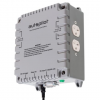Can I plug straight into the wall? -- I'm worried that the electrodes will get jossled and my bulb will go bad -- If I remember correctly, I've seen this with lightbulbs where if they aren't secure they go bad or maybe too if the power goes up and down.
I'd prefer having an on off switch on the side of the wall, I run practically all the time (veg). -- suggestions for a outlet switch?
it is around 150w hps remote ballast / reflector & bulb.
Thanks
I'd prefer having an on off switch on the side of the wall, I run practically all the time (veg). -- suggestions for a outlet switch?
it is around 150w hps remote ballast / reflector & bulb.
Thanks

